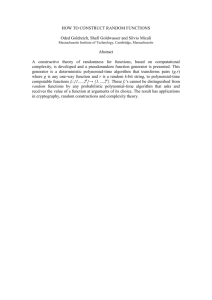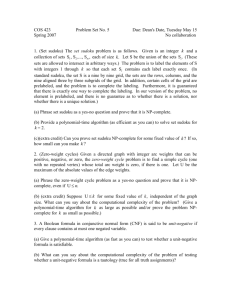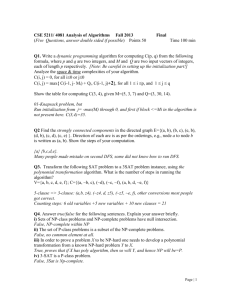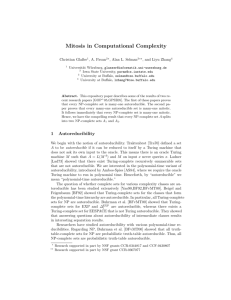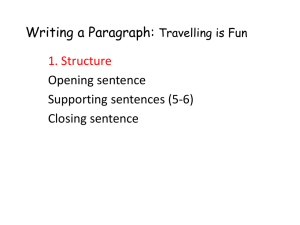NP completeness
advertisement
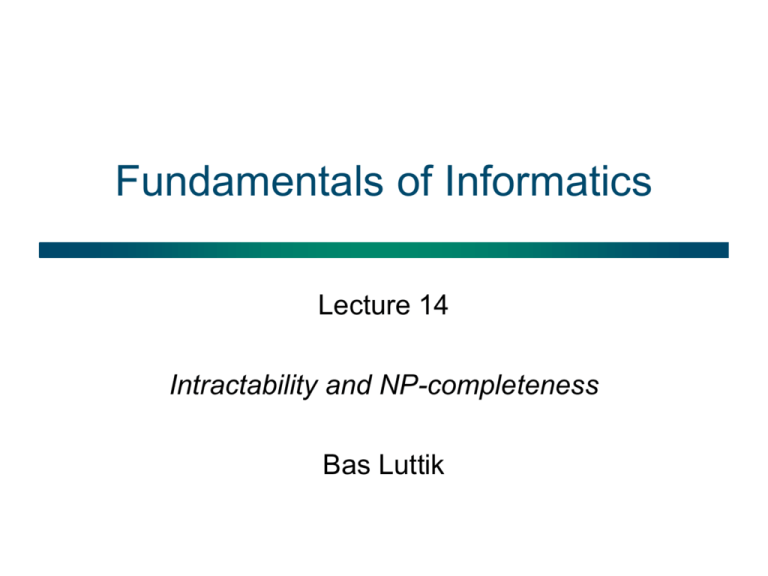
Fundamentals of Informatics
Lecture 14
Intractability and NP-completeness
Bas Luttik
Algorithms
A complete description of an algorithm consists of
three parts:
1. the algorithm
2. a proof of the algorithm’s correctness
3. a derivation of the algorithm’s running time
Should we really care about the running time of an algorithm?
Couldn’t we just improve our hardware, to compensate for the
inefficiency of an algorithm?
Towers of Hanoi
Rules of the game:
1. Rings can only be moved one at the time
2. Rings may not be placed on top of smaller rings.
Towers of Hanoi (running time analysis)
Hanoi(n,x,y,z)
// move n rings from peg x to peg y using peg z
1. if n = 1
2.
then move ring from x to y
3.
else
4.
Hanoi(n-1,x,z,y)
5.
move ring from x to y
6.
Hanoi(n-1,y,z,x)
Solving the recurrence
T(n) = 2T(n-1)+O(1)
yields T(n)=O(2^n)!
A more efficient solution does not exist!
T(n)
O(1)
O(1)
T(n-1)
O(1)
T(n-1)
Running times
How long does it take to run an algorithm on a computer capable
of a million instructions per second?
Input length
polynomial
exponential
10
20
50
100
200
n2
1/10000 s.
1/2500 s.
1/400 s.
1/100 s.
1/25 s.
n5
1/10 s.
3.2 s.
5.2 m.
2.8 h.
3.7 d.
2n
1/1000 s.
1 s.
35.7 y.
4 x 1011 c.
1 x 1045 c.
nn
2.8 h.
3.3 x 109 y.
1 x 1070 c.
1 x 10185 c.
1 x 10445 c.
polynomial-time algorithm:
algorithm with running time of O(nc) for some constant c.
P: the class of all decision problems for which there exists polynomialtime algorithm that solves it.
Tractable versus intractable problems
Tractable
A problem is tractable if there exists a
polynomial-time algorithm for it (i.e., if
it is in the class P)
Intractable
A problem is intractable if there does not
exist a polynomial-time algorithm for it.
Unsolvable
A problem is unsolvable if there does not
exist an algorithm for it (not even an
inefficient one).
Two decision problems about graphs
Problem 1:
Input: a road map of cities, with distances attached
to road segments,
twopath
designated
cities A and B
shortest
problem
and an integer(known
k.
to be in P)
Output: ‘Yes’ if it is possible to take a trip from A to
B of length ≤ k, and ‘No’ if such a trip is impossible.
Problem 2:
Input: a road map of cities, with distances attached
to road segments, two designated cities A and B
and an integer
k. salesman problem
travelling
Output: ‘Yes’ if it is possible to take a trip from A to
(unknown whether it is in P)
B of length ≤ k which passes through all the cities,
and ‘No’ if such a trip is impossible.
Travelling Salesman decision problem
travelling salesman decision problem
Input: A road map with n locations (one of the locations is
the depot) connected by road segments, with distances
attached to the road segments, and an integer k.
Output: Yes if there exists a route of distance less or equal
k that starts and ends at the depot and visits all locations on
the map exactly once. No otherwise.
A solution to the travelling salesman problem is a list l0,…,ln of n+1
locations such that
1. the depot is both the first (l0) and the last (ln) location in the list,
2. all the other locations occur exactly once in the list, and
3. the sum of the distances between successive locations in the list is
less or equal k.
Note that it can be verified with a polynomial-time algorithm whether some
candidate list l0,…,ln is a solution.
Travelling Salesman decision problem
travelling salesman decision problem
Input: A road map with n locations (one of the locations is
the depot) connected by road segments, with distances
attached to the road segments, and an integer k.
Output: Yes if there exists a route of distance less or equal
k that starts and ends at the depot and visits all locations on
the map exactly once. No otherwise.
A solution to the travelling salesman problem is a candidate list l0,…,ln of
n+1 locations satisfying the three conditions on the previous slide, and the
conditions can be verified with a polynomial-time algorithm.
A naïve algorithm for solving the travelling salesman decision problem
searches exhaustively through all candidate solutions.
The difficulty is: there are n! = n(n-1)(n-2)321 such candidate lists.
So: searching for a solution is hard, but verifying a solution is easy.
Problems in NP
The travelling salesman problem has the following characteristics:
1. Given some candidate solution, it can be verified in polynomial
time whether it is a correct solution.
2. There are too many candidate solutions to allow an efficient
solution that exhaustively searches for a correct solution among
the candidate solutions.
A candidate solution to a problem will be called a certificate for the
problem.
NP: the class of all decision problems for which there exists a suitable
notion of certificate and a polynomial-time algorithm to verify whether a
certificate is an actual solution to the problem.
(NP stands for Non-deterministic Polynomial time)
Boolean formula satisfiability (SAT)
A boolean formula consists of 0/1-valued variables and operators AND,
OR, NOT with the following interpretation:
x
y
x AND
x OR y
A ycertificate
0
0
0
1
x the
NOTboolean
x
for
satisfiability problem is an
Examples:
verification
boils
to checking
whether the
0assignment;
0
0
1
1.
xdown
AND (NOT
x)
assignment
satisfies
the formula.
2.
(((NOT x) OR y) AND (x AND (NOT z)))
0
1
1
0
1
0
0So:
1
1
1
the1 boolean satisfiability problem is in NP.
A boolean formula is satisfiable if there exists an
1
assignment of 0/1-values to its variables such that
the formula evaluates to 1.
boolean satisfiability problem
Input: A boolean formula.
Output: Yes if the formula is satisfiable. No otherwise.
A solution to the boolean satisfiability problem is a satisfying assignment;
there are 2n candidate assignments.
Subset-sum
subset-sum problem
Input: An finite set S of positive integers and a target number t.
Output: Yes if S has a subset whose elements sum exactly to t. No
otherwise.
Example:
A certificate for the subset-sum problem is a subset of S;
If S is verification
the set
boils down to checking that the numbers in the
t. 686, 2409, 2793, 16808, 17206, 117705, 117993}
{1 subset
,2, 7, 14,add
49,up
98,to
343,
So: the subset-sum
problemofisthe
in NP.
and t=138457,
then the elements
subset
{1, 2, 7, 98, 343, 686, 2409, 17206, 117705}
is a solution.
A candidate solution is a subset of S. There are 2|S| candidate solutions
(where |S| is the number of elements of S).
Hamiltonian-cycle decision problem
A hamiltonian cycle in an undirected graph is
a path in the graph that starts and ends with
the same vertex and visits each vertex exactly
once.
A certificate for the hamiltonian-cycle problem is a
hamiltonian-cycle
permutation of the vertices
of the graph problem
with the first vertex
added at the end. Verification
down tograph.
checking
Input: Anboils
undirected
whether the resulting list
of vertices
corresponds
a path in
Output:
Yes if the
graph hastohamiltonian
the graph.
cycle. No otherwise.
So: the hamiltonian-cycle problem is in NP.
If the input graph has n vertices, then a candidate solution is any
permutation of these n vertices with the first vertex in the permutation
added at the end. There are n! candidate solutions.
NP-complete problems
A problem is in de class NP if there exists a polynomial-time algorithm
to verify whether a certificate is an actual solution to the problem.
A problem is NP-hard if the existence of a polynomial-time algorithm to
solve the problem implies the existence of polynomial-time algorithms
for all the other problems in NP.
A problem is NP-complete if it is NP-hard and in NP.
Theorem: The boolean satisfiability problem
is NP-complete.
Stephen Cook
Leonid Levin
Reduction revisited
efficient
Problem A
efficient
Problem B
A reduction from
decision Problem A to decision Problem B consists of two
efficient
parts:
1. a general method (algorithm) for transforming every question of problem A
into an question of problem B
2. an argument that the B-answer to every transformed A-question can be
interpreted as a (correct) answer to the original A-question. (Sometimes Banswers need to be
negated.)
efficient
efficient
Note that if we have a solution for decision problem B and a reduction from A
to B, then we can effectively use it to solve problem A.
efficiently
Roughly, if there exists an efficient reduction from problem A to problem B,
then problem A is cannot be fundamentally harder than problem B.
Reduction revisited
Problem A
Problem B
A polynomial-time reduction from decision Problem A to decision Problem B
consists of two parts:
1. a polynomial-time algorithm for transforming every question of problem A
into an question of problem B
2. an argument that the B-answer to every transformed A-question can be
interpreted as a (correct) answer to the original A-question. (Sometimes Banswers need to be negated.)
Note that if we have a polynomial-time algorithm for decision problem B and a
polynomial-time reduction from A to B, then we can use it to construct a
polynomial-time algorithm for decision problem A (see next slide).
Polynomial-time reduction
input x
to A
polynomial-time
input y
reduction algorithm
to B
from A to B
yes
polynomial-time
algorithm for B
no
polynomial-time algorithm for A
Consider a polynomial-time reduction algorithm from A to B that converts
every input x for A to an input y for B in such a way that:
1. If the answer in B for y is yes, then the answer in A for x is yes.
2. If the answer in B for y is no, then the answer in A for x is no.
If the reduction algorithm runs in O(nc) and the algorithm for B runs in
O(md), then the resulting algorithm for A runs in O(nc + ncd).
Composing polynomial-time reductions
yes
poly.-time
reduction alg.
from C to A
input Z
to C
input x
to A
poly-time
reduction alg.
from A to B
input y
to B
poly-time
alg. for B
no
polynomial-time reduction algorithm from C to B
polynomial-time algorithm for C
If A is NP-hard, and there is a polynomial-time reduction algorithm from A
to B, then from every problem C in NP there exists a polynomial-time
reduction algorithm to B.
Therefore:
If A is NP-hard, and there exists a polynomial-time reduction algorithm
from A to B, then B is NP-hard too!
So: it suffices to reduce just one NP-hard problem to B (instead of all NP
problems) to show that it is NP-hard!
The mother problem
NP-complete
boolean formula satisfiability
Theorem: The boolean satisfiability problem
is NP-complete.
Stephen Cook
Leonid Levin
Subset-sum
subset-sum problem
Input: An finite set S of positive integers and a target number t.
Output: Yes if S has a subset whose elements sum exactly to t. No
otherwise.
A certificate for the subset-sum problem is a subset of S; verification boils
down to checking that the numbers in the subset add up to t.
So: the subset-sum problem is in NP.
The book explains the details of an intricate polynomial-time reduction
from (a variant of) boolean satisfiability to the subset-sum problem.
So: the subset-sum problem is NP-hard.
Conclusion: the subset-sum problem is NP-complete.
Hamiltonian-cycle
hamiltonian-cycle problem
Input: An undirected graph.
Output: Yes if the graph has hamiltonian cycle. No otherwise.
A certificate for the hamiltonian-cycle problem is some permutation of the
list of vertices of the graph, with the first vertex of the list repeated at the
end. Verification amounts to checking that the list is indeed a path in the
graph.
So: the hamiltonian-cycle problem is in NP.
The book presents a polynomial-time reduction (in several steps) from (a
variant of) boolean satisfiability to the hamiltonian-cycle problem.
So: the hamiltonian-cycle problem is NP-hard.
Conclusion: the hamiltonian-cycle problem is NP-complete.
A family tree of reductions
NP-complete
boolean formula satisfiability
hamiltonian-cycle
subset-sum
Travelling Salesman (TSP)
travelling salesman decision problem
Input: A road map with n locations (one of the locations is the depot) connected by
road segments, with distances attached to the road segments, and an integer k.
Output: Yes if there exists a route of distance less or equal k that starts and ends
at the depot and visits all locations on the map exactly once. No otherwise.
A certificate for TSP is some permutation of the list of n+1 locations
starting and ending with the depot. Verification amounts to checking that
every location is in the list and the sum of the distances is less than or
equal to k.
So: TSP is in NP.
Reducing hamiltonian-cycle to TSP
A hamiltonian cycle in an undirected graph is
a path in the graph that starts and ends with
the same vertex and visits each vertex exactly
once.
hamiltonian-cycle problem
Input: An undirected graph.
Output: Yes if the graph has hamiltonian
cycle. No otherwise.
To reduce the hamiltonian-cycle problem to the traveling salesman
problem (TSP) assign to all edges a weight of 0, and then add all missing
edges (grey edges in the above graph) with a weight of 1.
Then the original graph has a hamiltonian cycle if, and only if, the
resulting graph has a TSP-route of distance 0.
Travelling Salesman (TSP)
travelling salesman decision problem
Input: A road map with n locations (one of the locations is the depot) connected by
road segments, with distances attached to the road segments, and an integer k.
Output: Yes if there exists a route of distance less or equal k that starts and ends
at the depot and visits all locations on the map exactly once. No otherwise.
A certificate for TSP is some permutation of the list of n+1 locations
starting and ending with the depot. Verification amounts to checking that
every location is in the list and the sum of the distances is less than or
equal to k.
So: TSP is in NP.
We have sketched a polynomial-time reduction from the hamiltoniancycle problem to TSP (see also the book).
So: TSP is NP-hard.
Conclusion: TSP is NP-complete.
A family tree of reductions
NP-complete
boolean formula satisfiability
hamiltonian-cycle
travelling salesman
subset-sum
Partition
partition problem
Input: An finite set S of positive integers.
Output: Yes if S can be partitioned into S1 and S2 such that the sum of the
elements in S1 is equal to the sum of the elements in S2. No otherwise.
A certificate for the partition problem consists of two disjoint subsets S1
and S2 of S such that the union of S1 and S2 is S.
Verifying whether a certificate is a solution amounts to compute sums of
the elements of S1 and S2 and checking whether the sums are equal.
So: the partition problem is in NP.
We have presented a reduction from subset-sum to partition.
So: the partition problem is NP-hard.
Conclusion: the partition problem is NP-complete.
Reducing subset-sum to partition
subset-sum problem
Input: An finite set S of positive integers and a target number t.
Output: Yes if S has a subset whose elements sum exactly to t. No
otherwise.
Let S, t be some input to the subset-sum problem
Let z be the sum of the elements of S.
Let y > t+z, 2z; add y-t and y-z+t (both >z!) to S to obtain S’.
On the one hand, if S has a subset with sum t, then S’ can be partitioned!
If S’ can be partitioned, then one of the subsets contains y-t and the other
contains y-z+t. Since the size of the entire set (y-z+t)+z+(y-t)=2y, it follows
that a partition includes a subset of S of size y-(y-t)=t.
So S has a subset with sum t if, and only if, S’ can be partitioned.
S’ can be obtained from S in polynomial time.
Partition
partition problem
Input: An finite set S of positive integers.
Output: Yes if S can be partitioned into S1 and S2 such that the sum of the
elements in S1 is equal to the sum of the elements in S2. No otherwise.
A certificate for the partition problem consists of two disjoint subsets S1
and S2 of S such that the union of S1 and S2 is S.
Verifying whether a certificate is a solution amounts to compute sums of
the elements of S1 and S2 and checking whether the sums are equal.
So: the partition problem is in NP.
We have presented a polynomial-time reduction from subset-sum to
partition.
So: the partition problem is NP-hard.
Conclusion: the partition problem is NP-complete.
A family tree of reductions
NP-complete
boolean formula satisfiability
hamiltonian-cycle
subset-sum
travelling salesman
partition
Limits of computation
For a class of important decision problems (the
NP-complete problems), it is unknown whether
they are tractable or intractable.
Tractable
NP-complete
Intractable
Unsolvable
Note: they are all tractable or all intractable!
A decision problem is
tractable if there exists a polynomialtime that solves it
intractable if there exists an algorithm
that solves it, but not a polynomial-time
algorithm
unsolvable if there does not exist an
algorithm that solves it
The holy grail
Multiplication
36746043666799590428244633799
62795263227915816434308764267
60322838157396665112792333734
17143396810270092798736308917
33478071698956898786044169848
21269081770479498371376856891
24313889828837938780022876147
11652531743087737814467999489
1230186684530117755130494958384962720772853569595334792197
3224521517264005072636575187452021997864693899564749427740
6384592519255732630345373154826850791702612214291346167042
9214311602221240479274737794080665351419597459856902143413
Factorization
36746043666799590428244633799
62795263227915816434308764267
60322838157396665112792333734
17143396810270092798736308917
33478071698956898786044169848
21269081770479498371376856891
24313889828837938780022876147
11652531743087737814467999489
1230186684530117755130494958384962720772853569595334792197
3224521517264005072636575187452021997864693899564749427740
6384592519255732630345373154826850791702612214291346167042
9214311602221240479274737794080665351419597459856902143413
Factorization
That factorization is hard, is actually a good thing: it is at the heart of
public-key cryptography!
Factorization is actually in NP. (What’s the certificate?)
So, public-key cryptography is in trouble in the (unlikely) case that P=NP .
It is unknown whether factorization is NP-hard.
Factorization currently essentially involves exhaustively searching the
enormous search space of candidate divisors. But it may happen that
an alternative to searching is found.
For the related problem of primality testing (which, at first sight, also
involves searching), an alternative to searching has been found and
led to polynomial-time algorithm!
Material
Chapter 10 discusses many NP-complete problems, and
presents reductions between them
(Refer to chapter 9 again for an explanation of public-key cryptography and RSA.)
Deadline:
January 15, 2016
